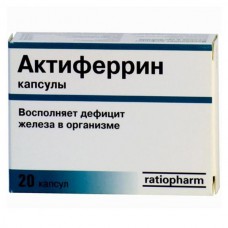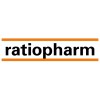Expiration date: 02/2026
The composition and form of issue:
Capsules. 1 caps. contains active substances:
iron sulphate, dried 113,85 mg
(corresponds to 34.5 mg of iron (II)
D,L-serine 129 mg
excipients: rapeseed oil (refined) — 142,15 mg oil, soybean (hydrogenated) — 7.5 mg oil, soybean (partially hydrogenated) 30 mg lecithin (E322) — 10 mg yellow wax — 7.5 mg
capsule shell: gelatin — 161,64 mg glycerol 85% in the accounting period by 40.23 mg digidrirovanny substance of the sorbitol liquid (70%) rekristallizatsiya — 26,27 mg iron oxide black (E172) C. I. 77499 — 2,16 mg iron oxide red (E172) C. I. 77491 — 0.9 mg
blistere in 10 PCs. in cardboard pack 2, or 5 blisters.
Syrup. 100 ml contains active substances:
iron sulfate geptagidrat of 3.42 g
(corresponds to 0,687 g of iron (II)
D,L-serine of 2.58 g
excipients: ascorbic acid — 0.4 g invert syrup (72,7% TS) to 86.6 g of raspberry flavoring — 0.1 g butter flavouring 0.025 g ethanol (96%) — 0,3133 g of purified water and 32.3 g
in dark glass bottles with jet tube 100 ml in cardboard pack 1 bottle.
Drops for reception inside. 100 ml contains active substances:
iron sulfate geptagidrat 4,72 g
(corresponds to 0,9483 g of iron (II)
D,L-serine 3,56 g
excipients: potassium sorbate — 0.1 g ascorbic acid 0.8 g invert syrup (72,7% TS) — 15,18 ethanol (94%) — 0,1563 raspberry flavor, 0.05 g of butter flavoring — 0.0125 g purified water — 83,4262 g
in dark glass bottles of 30 ml, with stopper-dropper in the paper cartons 1 a bottle.
Description pharmaceutical form:
Capsule — a soft, gelatinous, brown, oblong, opaque, contain light beige (to greenish-grey) buttery pasta.
The syrup is translucent, greenish to yellow-brown color liquid with a raspberry-cream aroma.
Drops for reception inside transparent, greenish to yellow-brown color liquid with a raspberry-cream aroma.
Pharmacological action:
Iron is essential for the functioning of the body: part of hemoglobin, myoglobin, various enzymes reversibly binds oxygen and takes part in several redox reactions stimulates erythropoiesis. Part of the preparation of alpha-amino acid serine contributes to more effective iron absorption and its entry into the systemic circulation, leading to rapid recovery of its normal content in the body. It provides the best tolerability and allows to reduce the required dose of iron. Quickly replenishes the deficiency of iron in the body, contributing to the progressive regression of clinical (weakness, fatigue, dizziness, tachycardia, soreness and dryness of the skin) and laboratory symptoms of anemia.
Pharmacokinetics:
After intake of being a part of the product's iron is adequately absorbed from the gastrointestinal tract into the systemic circulation. There is a correlation between the degree of iron deficiency and the amount absorbed into the systemic circulation iron (the higher iron deficiency, the better suction). Tmax is achieved within the first 2-4 h after administration of the drug. Excreted in the urine, feces, sweat.
Indications:
Iron deficiency anemia of various etiologies latent iron deficiency associated with excessive loss of iron (bleeding, including uterine permanent donation) or increased need (pregnancy, lactation, active growth period, malnutrition, chronic gastritis with secretory insufficiency, condition after stomach resection, gastric ulcer and duodenal ulcers, reducing resistance of the organism of adults and children with infectious diseases, tumors).
Contraindications:
Hypersensitivity to the preparation components iron overload (hemosiderosis, hemochromatosis), other types of anemia not caused by iron deficiency sideroahrestical anemia, anemia in lead poisoning, hemolytic and aplastic anemia, late porphyria skin chronic hemolysis.
Application of pregnancy and breast-feeding:
In established iron deficiency drug use during pregnancy and the breastfeeding period is considered reasonable and safe.
Side effects:
Gastrointestinal: loss of appetite, bitter taste in mouth, flatulence, constipation, diarrhea, rarely — abdominal pain, nausea, vomiting.
Allergic reactions: itching, rash, rarely — anafilaktichesky shock.
Other symptoms: headache, dizziness, flushing of the skin, toothache, sore throat, weakness, feeling of pressure in the chest, irritability, rarely, encephalopathy with epileptic syndrome.
Drug interactions:
Deferoxamine — specific antidote. Antacids, calcium supplements, heteronomy acid, drugs that reduce gastric acidity (e.g. cimetidine, drugs that contain carbonates, bicarbonates, phosphates, oxalates), Pancreatin, milk, vegetables, cereals, egg yolk, tea, coffee reduce the absorption of the drug (interval between meals should be 1-2 h). Ascorbic acid increases the absorption. Reduces the absorption of fluoroquinolones, effective in, tetracycline (the interval between doses also need to be 2 hours).
Large doses of iron preparations reduce renal absorption of zinc supplementation (interval between meals should be 2 hours). Ethanol increases the absorption of iron and the risk of toxic complications.
Method of application and dose:
Inside, immediately before meals or during meals. The capsules do not chew, washed down with plenty of water. Syrup and drops to take small amount of liquid (fruit tea or water).
If the doctor has not appointed other dosage, you should strictly adhere to the instructions outlined below.
Capsules (the most convenient form for adults and adolescents)
Adults and adolescents at the beginning of therapy usually appoint 1 KAPS. 2-3 times a day. However, poor tolerability reduce dose to the maximum tolerated. In this case, the duration of therapy (up to haemoglobin) increases.
Children over 6 years appoint 1 caps. on a daily basis.
Drops (the most convenient form for infants and young children)
The daily dose is set at the rate of 5 drops/kg factor destination, 2-3 times a day.
Infants: the average dose is 10-15 drops 3 times a day.
Children of preschool age: the average dose — 25 to 35 drops 3 times a day.
School-age children: the average dose — 50 drops 3 times a day.
Syrup (the most convenient form for children older than 2 years)
Dose: 5 ml per 12 kg of body weight.
School-age children: the average dose is 5 ml 2-3 times a day.
Children of preschool age: the average dose is 5 ml 1-2 times a day.
Note: to open the bottle, press the cap down and simultaneously turning in the direction of the arrow. After applying the medication cap and tight set screw (prevents access for children).
After reaching normal levels of serum iron and hemoglobin treatment maintenance dose is continued for at least 8-12 weeks, assigning a maintenance dose.
Overdose:
Symptoms: weakness, fatigue, paresthesias, pallor, cold clammy sweat, decreased blood pressure, heart rate, acrocyanosis, abdominal pain, diarrhea with blood, vomiting, cyanosis, confusion, weak pulse, hypothermia, lethargy, seizures, symptoms of hyperventilation, coma.
Signs of peripheral circulatory collapse is manifested within 30 min after administration metabolic acidosis, seizures, fever, leukocytosis, coma — within 12-24 hours acute renal and hepatic necrosis — 2-4 days.
Treatment: before carrying out specific treatment — take steps to remove even nevsosavsheysya of the drug (gastric lavage), give milk, raw eggs. Specific therapy — deferoxamine oral and parenteral. In acute poisoning to bind more nevsosavsheysya of iron from the gastrointestinal tract, are inside 5-10 g of the drug by dissolving 10 to 20 vials in drinking water.
With the development of the phenomena of poisoning deferoxamine injected I/m slowly, children — 15 mg/HR for adults, 5 mg/kg/h (up to 80 mg/kg/day) in mild poisoning: in/m, children — 1 g every 4-6 hours, adults — 50 mg/kg (up to 4 g/day) in severe poisoning accompanied by shock, in/in drip administered 1 g of the drug and symptomatic therapy.
Hemodialysis is not effective for removal of iron, but can be used to accelerate excretion of the iron-deferoxamine complex, and can be administered with oligo - and anuria. Possible to carry out peritoneal dialysis.
Precautions:
Caution: patients with gastric ulcer and duodenal ulcer, inflammatory bowel disease (enteritis, diverticulum, ulcerative colitis, Crohn's disease), alcoholism (active or in remission), allergies, asthma, hepatitis, hepatic or renal insufficiency, rheumatoid arthritis, blood transfusion.
Caution must be exercised in the appointment of syrup or drops in patients with diabetes mellitus — 1 teaspoon of syrup contains 1.8 g of glucose, and 18 drops (1 ml) of 64 mg, which is equivalent to 0,15 0,0053 XE and XE, respectively.
Suction reduces black tea, coffee, milk and solid food, bread, raw cereals, dairy products, eggs.
Special instructions:
In the course of administering the drug requires systematic monitoring of hemoglobin.
To prevent the appearance on the teeth of patients with reversible dark plaque Aktiferrin syrup and drops should not be taken in undiluted form, and after ingestion it is recommended to thoroughly clean the teeth.
Marked staining of stool in black.
To open the bottle must press down on the cap down and simultaneously turning in the direction of the arrow. After applying the cap to install and tightly screw (prevents access for children).
Storage conditions:
Protect from moisture.





